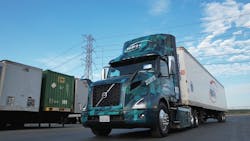I’ve spent a fair amount of time lately talking about the viability and benefits of battery-electric vehicles (BEVs) in commercial applications. And in many trucking applications BEVs make a great deal of sense. In Run on Less—Electric, 13 BEVs operating in four distinct market segments—vans and step vans, medium-duty box trucks, terminal tractors, and regional haul heavy-duty tractors—demonstrated their ability to deliver goods in real-world applications. What these four market segments have in common is known routes, a relatively short number of miles driven per day, and return-to-base operations that allow for charging back at headquarters.
But I would be naïve if I told you that BEVs make sense for all applications. The truth is the technology just is not there yet for all duty cycles. For trucks traveling long distances, those with disparate routes and fleets using team drivers, battery-electric trucks are not the right choice, today. That is not to say they won't be a good option in the future, but for now they don't make practical sense.
See also: It’s 'go time' for electrification
I also think the jury is still out on the efficacy of BEVs in extremely cold operating conditions. There also are some vocational applications with complex auxiliary loads where BEVs will not be a good fit. This will be very interesting as some of these complex trucks might benefit from the flexibility that wires and batteries provide over more rigid mechanical components of internal combustion engines. More on that later from me.
Fleets also should factor in where they are operating as part of their analysis of whether BEVs make sense for them. In our report, "High Potential Regions for Electric Truck Deployments," we proposed a three-part framework to help prioritize regions for electric truck deployment.
- Technology: Identify the regions that are most favorable to the unique attributes of the technology.
- Need: Identify the regions that exhibit the greatest need for electrification.
- Support: Identify the regions that provide the most support for the technology.
For example, if you are operating in a region where utilities do not have a good understanding of the diverse considerations surrounding electric trucks, you may want to hold off on deploying BEVs. Successful deployment of BEVs requires working cooperatively with local utilities, especially when larger numbers of BEVs are being put into operation.
See also: Lessons learned about electrification
When it comes to BEVs in commercial applications, it is critical that you get the right vehicle for the right duty cycle in the right location. In some ways this is no different than what fleets have been doing when spec’ing their diesel-powered vehicles. Regardless of power source, matching the right truck to the duty cycle is critical for success.
However, when it comes to BEVs, choosing the wrong application can sour a fleet on the technology. The reality is that BEVs make a great deal of sense in some applications. So, if you are operating in a market segment or duty cycle where BEVs make sense, by all means start integrating them into your operations. But if the fit is not right, my advice is to wait until the technology catches up to your needs. That way, when you finally add BEVs, you will be happy you did.
Michael Roeth has worked in the commercial vehicle industry for nearly 30 years, most recently as executive director of the North American Council for Freight Efficiency. He serves on the second National Academy of Sciences Committee on Technologies and Approaches for Reducing the Fuel Consumption of Medium and Heavy-Duty Vehicles and has held various positions in engineering, quality, sales, and plant management with Navistar and Behr/Cummins.
About the Author

Michael Roeth
Executive Director
Michael Roeth is the executive director of the North American Council for Freight Efficiency. He serves on the second National Academy of Sciences Committee on Technologies and Approaches for Reducing the Fuel Consumption of Medium and Heavy-Duty Vehicles and has held various positions with Navistar and Behr/Cummins.
